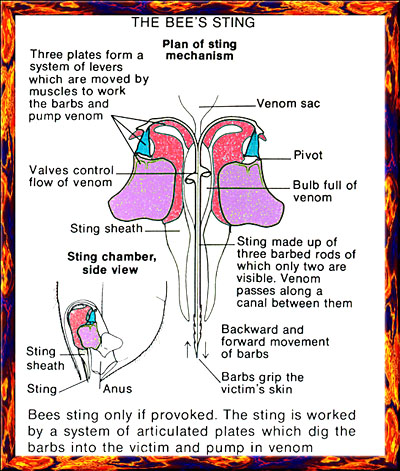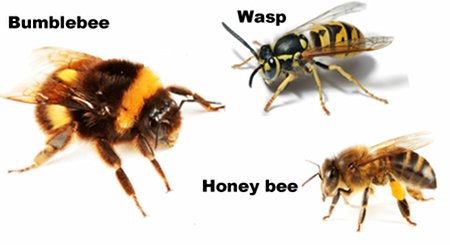Hey guys. Sorry for not posting for a while- I've been fairly busy what with the end of track and the school year fast approaching. My last meet will be tomorrow! Either way, today I will be doing a "class" on some of the basic things that go into a bee's life.
First off, I should say that I did inspect the colony last Sunday, and we had our first sting. It was on my father's stomach, and really wasn't bad at all. I'm not looking forward to my first sting, but I have been stung by a wasp before, and there is no way it will be as bad as that was.
And that leads us into our first lesson! Stings! First off, I would like to say that what most people think are bee stings are really wasp stings. Those are much more painful and unprovoked and the cause of much unnecessary fears of honey bees. Wasps are carnivorous, angry insects who will sting with no real reason. They can also sting multiple times as opposed to the honey bee (and most to all bees I would assume) who die after a sting.
When a honey bee stings, her stinger gets logged into the flesh of the mammal (she doesn't loose it when stinging other insects) because of the barb on her sting. It resembles the pointed tip of a fish hook for the mental picture. Because of this barb, the bee looses her life in a slow death, as the stinger is attached to the venom sacks and part of her intestines, which you may see attached to the stinger when you remove it.
(please click on the image for a closer look)
It is for this reason that a lone, flying foager honey bee should not be feared in the slightest. The only time in which a honey bee will willingly give up her life would be if the colony was under attack. One way to think of this is to put it to the likeness of your own body. The human body is made up of individual living cells, but those cells work together to support the life of a complex being. The colony is much the same way. Each worker bee is a cell with a specific job, and, much like the white blood cells of our bodies, the guard bees are on the defensive.
Now that the reasons and consequences behind honey bee stings are covered, it it time to explain sting treatment. Over all, the only thing that needs to be done to help a honey bee sting is to remove the stinger as quickly as possible. This should be done with the finger nail (or a credit card, but I would highly recommend the finger nail, as it takes time to get the card from your pocket.) in a scraping motion away from the sting. This is done so that all of the sting gets removed, and infection can be avoided. That said, bee stings don't generally get infected at all, but it is best to remove organic matter from the flesh. The other reason this is done so swiftly is because, going back to what I said about the structure of the sting, the venom sack is still attached to it, and if left alone, the amount of venom discharged into the flesh will be much higher, and the discomfort will be increased.
Besides removing the sting quickly, the other steps that can, but don't need to be done, are icing the stung spot to reduce inflammation and spreading of the venom (which will stay in the sting spot anyway, much like a misquote bite), and putting soothing skin ointments on the inflamed site.
Now that all this is said, I feel it necessary to say that, apart from the fact that honey bee stings are rare if unprovoked, and allergies to honey bee venom even more rare, stings are not something to be very afraid of. They only last about a day, and the discomfort if mild in most people. The initial feeling will resemble burning, but it will soon subside to an itch, and then to that of a misquote bite.
Environmental Tip Time:
Please help the bees by informing those who you know to fear bees of what I have just taught you. The major point to remember is that most people confuse wasp stings for bee stings, and that honey bees do not go out on suicide missions. Tell your friends that bees are generally quite friendly herbivores, and that it is in fact very safe and incredibly interesting for one to look closely at a bee resting on a flower per say. I would very much recommend for everyone to do this if they see a honey bee. I WOULD NOT, however, recommend one to look closely at a bee hive without the presence and approval of a beekeeper. Remember, the only real time to be worried about stings is when you do not properly prepare to enter a hive. Observing one from a safe distance of about, say five feet or so, is quite alright on the other hand.
And just to be sure that everyone will know the difference between the bees and wasps (so that they don't accentually take my advice and start observing wasps up close), here is a helpful image:
(please click on the image for a closer look)




